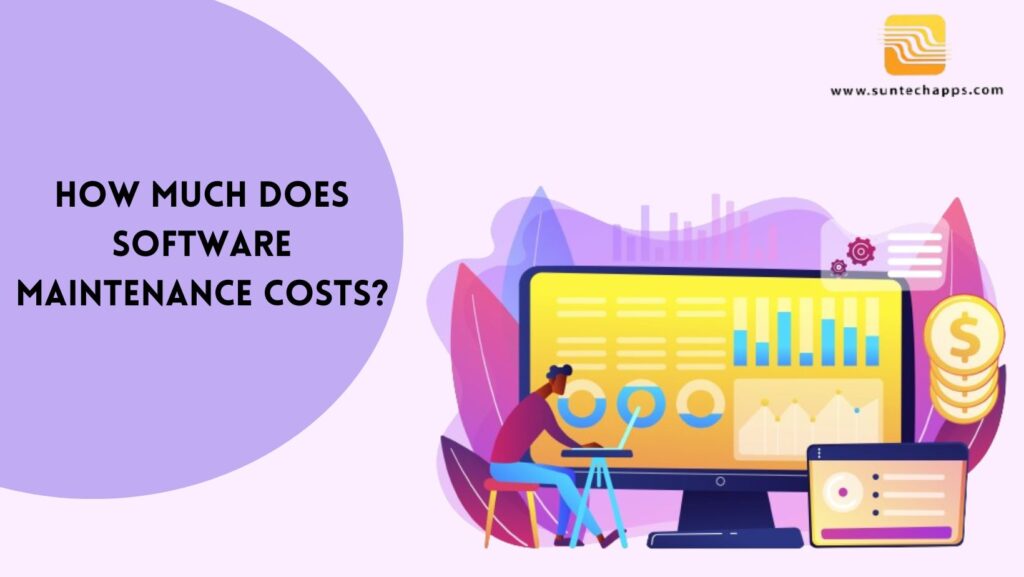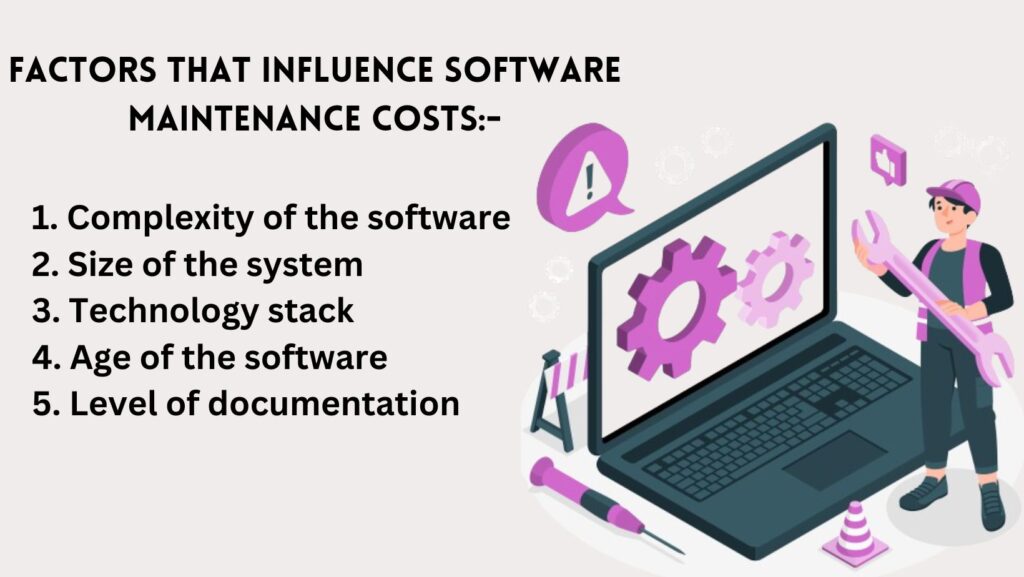How Much Does Software Maintenance Costs?
10 min read
Introduction
Software maintenance is an essential part of software development that ensures ongoing functionality, security, and performance of a software application. While many businesses focus on the initial costs of software development, it’s important not to overlook the expenses associated with software maintenance. These costs can vary depending on various factors, including the complexity of the software, the size of the development team, and the frequency of updates and bug fixes required. In this article, we will explore the factors that contribute to software maintenance costs and provide insights on how businesses can effectively manage and budget for this critical aspect of software development.
Analyzing The Cost To Maintain A Software
On average, software maintenance services cost 20-25% of the license cost annually; the remaining costs depend on several factors to be discussed later. For example, hiring dedicated software developers for maintenance may cost $7-$20 per hour. However, experts caution that neglecting maintenance can increase costs up to three times as much over time. Therefore, timely software maintenance is recommended. If you are unfamiliar with software maintenance costs and practices, this guide provides a comprehensive analysis to explain maintenance considerations in detail. Hire dedicated software developers.
Why software maintenance is crucial for businesses?
Why software maintenance is crucial for businesses
Software maintenance is crucial for businesses for several reasons. Firstly, it ensures the ongoing functionality of software applications. As technology evolves and new operating systems and platforms are introduced, software needs to be updated to remain compatible and continue working as intended. Without regular maintenance, software applications can quickly become outdated and experience compatibility issues, leading to decreased productivity and frustration for users.
Secondly, software maintenance plays a vital role in ensuring the security of applications. Cyber threats are constantly evolving, and software vulnerabilities need to be identified and patched to protect sensitive data and prevent unauthorized access. Regular maintenance allows businesses to stay ahead of potential security breaches and minimize the risk of costly data breaches.
Furthermore, software maintenance is essential for optimizing performance. Over time, software applications can accumulate bugs, inefficiencies, and bottlenecks that hinder performance. Regular maintenance allows for the identification and resolution of these issues, resulting in improved speed, efficiency, and user experience.
In conclusion, software maintenance is crucial for businesses to ensure ongoing functionality, security, and performance of software applications. Neglecting this critical aspect of software development can lead to compatibility issues, security vulnerabilities, and decreased productivity. Therefore, allocating resources and budgeting for software maintenance is essential for businesses to remain competitive in today’s rapidly changing digital landscape.

Types of software maintenance and their costs
When it comes to software maintenance, there are generally three types that businesses should consider: corrective maintenance, adaptive maintenance, and perfective maintenance.
Corrective maintenance involves fixing bugs and resolving issues in the software. This type of maintenance is usually conducted in response to user-reported problems and aims to restore the software to its intended functionality. The costs associated with corrective maintenance can vary depending on the complexity of the issue and the time required to fix it.
Adaptive maintenance focuses on making changes to the software to ensure it remains compatible with evolving technology and business requirements. This may include updating the software to work with a new operating system or integrating it with other systems. The costs for adaptive maintenance can vary depending on the complexity of the changes and the level of expertise required. As per the custom software development company professionals, this maintenance service focuses on enhancing software frameworks.
Perfective maintenance aims to improve the performance, usability, and efficiency of the software. This can involve optimizing code, adding new features, or enhancing the user interface. The costs for perfective maintenance can vary depending on the extent of the improvements and the resources required.
The costs of software maintenance will differ based on the specific needs and complexity of each business. It is important for organizations to allocate a budget for software maintenance and to work closely with development teams to determine the most effective and cost-efficient strategies. By investing in regular maintenance, businesses can avoid costly issues, such as system failures or data breaches, and ensure the longevity and success of their software applications.
In the next section, we will explore strategies for minimizing software maintenance costs and maximizing ROI.
Factors that influence software maintenance costs

Factors that influence software maintenance costs can vary greatly depending on the specific circumstances and requirements of each business. However, several key factors commonly contribute to the overall cost of software maintenance.
- Complexity of the software: Software with intricate code and complex functionalities may require more resources and expertise to maintain. The more complex the software, the higher the maintenance costs are likely to be.
- Size of the system: The size of the software application, including the number of modules, components, and lines of code, can also impact maintenance costs. Larger systems often require more extensive testing, debugging, and documentation, which can result in higher maintenance expenses.
- Technology stack: The technology stack used to develop the software can influence maintenance costs. Proprietary or less common technologies may require specialized skills and resources, which can be more expensive to maintain compared to widely adopted technologies with readily available expertise.
- Age of the software: Older software applications are more likely to require frequent and extensive maintenance to keep up with evolving technology and business requirements. Outdated software may need significant updates or even a complete rewrite, which can significantly impact maintenance costs.
- Level of documentation: Well-documented software can reduce maintenance costs by enabling developers to quickly understand and modify the code. On the other hand, poorly documented software may result in longer troubleshooting and debugging times, leading to increased maintenance expenses.
By considering these factors, businesses can better understand the potential costs associated with software maintenance and make informed decisions to optimize their maintenance strategies and maximize their return on investment. In the following section, we will delve into specific strategies for minimizing software maintenance costs.
Calculating and budgeting for software maintenance
Calculating and budgeting for software maintenance is an essential aspect of managing your business’s resources effectively. By accurately estimating maintenance costs, you can allocate the necessary funds and ensure that your software remains functional and up-to-date.
To calculate software maintenance costs, start by assessing the complexity and size of your software system. Evaluate the intricacy of the code and the number of modules, components, and lines of code. This analysis will help you determine the level of resources and expertise required for maintenance.
Next, consider the technology stack utilized in your software. If you’re using proprietary or less common technologies, factor in the additional expense of specialized skills and resources. Compare this to the costs associated with widely adopted technologies with readily available expertise.
The age of your software also plays a crucial role in determining maintenance expenses. Older applications might require substantial updates or even a complete rewrite, so consider potential costs for these scenarios.
Finally, examine the level of documentation for your software. The more comprehensive and organized your documentation, the more efficiently developers can troubleshoot and debug, resulting in lower maintenance expenses.
Once you have gathered this information, you can create a budget for software maintenance that aligns with your business goals and financial capabilities. Allocating an appropriate amount of resources for maintenance ensures that your software remains reliable, secure, and optimized for performance.
In the next section, we will explore strategies for minimizing software maintenance costs, helping you further optimize your budget and maximize your return on investment.
Best practices for minimizing software maintenance costs
To effectively minimize software maintenance costs, there are several best practices you can follow. By implementing these strategies, you can optimize your budget and maximize your return on investment.
- Regularly update and patch your software: Keeping your software up to date with the latest releases and patches can help prevent potential issues and security vulnerabilities. By doing so, you minimize the need for extensive maintenance and reduce the associated costs. Also, the cost to hire offshore PHP developers for both platforms differs, so decide it as per your budget.
- Conduct thorough testing: Before deploying any changes or updates to your software, conduct comprehensive testing to identify and address any potential bugs or issues. By catching and resolving these problems early on, you can avoid costly fixes and minimize maintenance expenses.
- Prioritize quality assurance: Investing in quality assurance processes and practices can significantly reduce maintenance costs. By incorporating rigorous testing frameworks, automated testing tools, and code reviews, you can ensure that your software is robust and resilient, thereby reducing the need for extensive maintenance.
- Foster proactive monitoring: Implementing a proactive monitoring system can help you identify and address issues as soon as they arise. By continuously monitoring your software’s performance, you can quickly respond to any potential problems, minimizing their impact and reducing the associated maintenance costs.
- Document extensively: Thorough and organized documentation plays a crucial role in minimizing maintenance expenses. By ensuring that your software’s documentation is comprehensive and easily accessible, you enable developers to troubleshoot and resolve issues more efficiently, resulting in reduced maintenance costs.
By following these best practices, you can effectively minimize software maintenance costs, ensuring that your budget is allocated efficiently and your software remains reliable, secure, and optimized for performance.
The long-term value of investing in software maintenance
While it’s important to minimize software maintenance costs, it’s equally essential to recognize the long-term value of investing in software maintenance. By proactively maintaining and supporting your software, you can extend its lifespan and continue to derive value from it.
Regular maintenance ensures that your software remains reliable and secure. As technology evolves and new vulnerabilities emerge, maintaining up-to-date software becomes crucial. By investing in regular updates and patches, you can protect your software against potential cyber threats and ensure the safety of your data and systems. So once your software is developed, avail of PHP web development services or any other to improve the performance of your software and keep it running lifetime.
Moreover, software maintenance allows you to adapt to changing business needs. As your organization grows or your industry evolves, you may need to modify or enhance your software to meet new requirements. By investing in software maintenance, you can effectively respond to these changes, ensuring that your software continues to support your business goals.
Additionally, proper maintenance can improve the performance and efficiency of your software. Through performance optimization, bug fixes, and code refactoring, you can enhance your software’s speed, stability, and overall user experience. This, in turn, can improve productivity, customer satisfaction, and ultimately, your bottom line.
In conclusion, while it’s important to minimize software maintenance costs, it’s crucial to recognize the long-term value of investing in software maintenance. By doing so, you can protect and enhance the reliability, security, and performance of your software, enabling it to continue adding value to your business.
Conclusion and final thoughts
In conclusion, understanding the costs associated with software maintenance is essential for any organization. While it may be tempting to only focus on minimizing these costs in the short term, it is crucial to recognize the long-term value that investing in software maintenance can provide.
By proactively maintaining and supporting your software, you can extend its lifespan and continue to derive value from it. Regular maintenance ensures that your software remains reliable and secure, protecting it against potential cyber threats and ensuring the safety of your data and systems.
Furthermore, software maintenance allows you to adapt to changing business needs and enhance the performance and efficiency of your software. By investing in updates, patches, and performance optimization, you can improve productivity, customer satisfaction, and ultimately, your bottom line.
Ultimately, software maintenance should be seen as an investment rather than merely a cost. By recognizing the long-term value it can provide, organizations can make informed decisions and ensure the continued success of their software systems.
So, if you want to get an exact cost to maintain software or the cost to hire a software developer, it is better to get in touch with professionals such as SunTech Applications. They will help you get an exact estimate of the software maintenance pricing and more.
Frequently Asked Questions
1. How Much Does it Cost to Maintain Travel Software?
The average maintenance cost for a travel app is typically 15-20% of the total development cost. For example, if a travel app costs $30,000 to develop, expect to budget around $4,500-6,000 annually for maintenance.
2. What Are the Different Types of Software Maintenance Services Are There?
There are four types of software maintenance –
- Preventive maintenance
- Corrective maintenance
- Adaptive maintenance
- Perfective maintenance
3. What are the Costs Factors involved in Software Maintenance?
There are basically two types of cost factors involved while maintaining a software
- Technical
- 2. Non-technical
4. Is Maintenance of Software Expensive?
While software maintenance and support can be costly for systems with lifetime service agreements, keeping your software up-to-date is critical. When pitching organizations on software development, be sure to discuss ongoing maintenance costs as well.
5. How Long Does It Take to Maintain A Software?
After developing a mobile app, it is wise to promptly seek maintenance services, as software requires ongoing support with no time limits. Regular maintenance keeps the app functioning optimally, avoids issues, and reduces costs down the road.
6. What Is the Average Cost to Maintain A Software?
The basic software maintenance cost is roughly 20 to 25 percent of the total mobile app development cost. If you hire mobile app developers to maintain the software, expect to pay $7 to $15 per hour.





